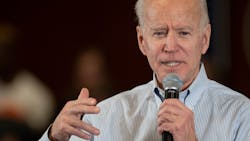A lot can happen in 100 days. In fact, that number seems to be a great benchmark for many things that happen in society today. It stands to reason that many things in our political world are often judged in the first 100 days. By the time you read this column, our nation will be transitioning from President Joe Biden’s inauguration to the key measuring statistic of what his first 100 days in office will look like. Rumor has it there could be a massive push to get an infrastructure bill finally bestowed upon our nation in this important 100-day timeframe.
We all know that talk of an infrastructure bill has been around since the 2016 election, and congressional inaction has prevented any meaningful bipartisan discussion from taking place regarding this much-needed regulation to fix our roads and bridges. However, since the election in November, it seems that no day has gone by without someone asking what an infrastructure bill could look like if the Biden administration were to move forward with this platform in his first 100 days.
Typically, when this conversation arises, I usually look into my crystal ball and lucky for me, the metaphorical crystal ball exists in the form of the House passage of the Moving Forward Act, a bill with a $1.5 trillion price tag that considers everything from roads and bridges to broadband. Originally deemed a Democratic wish list as attached amendments were put forth and voted up or down strictly among party lines, the massive bill falls just short of the true conversation that must be had when looking to move such a large piece of legislation— the pay-fors.
Any passage of this bill must account for making the Highway Trust Fund a sustainable resource for road and bridge improvements. If 2020 and COVID-19 taught us anything, it reaffirmed the notion that freight moves much easier when roads and bridges are less congested, thus demonstrating the need for infrastructure improvements all across the country. Funding the nation’s infrastructure is no small endeavor, and creating a fully sustainable Highway Trust Fund is key to rebuilding and repairing our nation’s roads and bridges. The Truckload Carriers Association supports an increase to the federal fuel tax and indexing it to inflation to pay for this effort, as this method remains the most cost-effective way to raise dollars to support our infrastructure investment.
Theoretically speaking, the funding has always seemed to be the issue that has held up any push on infrastructure in the past. While the safety titles that may make their way into this bill would certainly allow for some interesting dialog, real conversations can only happen surrounding these measures when the funding side is taken seriously. Regardless, the effect of a new highway reauthorization bill on an industry that serves as the backbone of America would be paramount in terms of the improvements that would happen if the dollars are correct.
Now, seeing as we have made it out of the holiday season and are still in the midst of a global pandemic, many have familiarized themselves with stretching a dollar as far as it will go in terms of charitable donations. In fact, when donating, I usually find the right organization in which the near totality of any dollar is put toward helping people, not toward overhead costs. That knowledge, in and of itself, should also be seen as the basis of a fuel tax increase to support the rebuilding of this nation.
Think about it. Does the best investment consist of one that has an administrative cost of approximately 1%, which would be the federal fuel tax, or one which generates overhead costs exceeding 10%, which would be electronic tolling? While tolling has had a long history in the United States, I believe the time has come for this nation to entertain the conversation that a sound investment in our infrastructure, one that creates a sustainable Highway Trust Fund, is a measure best suited for an increase in the federal fuel tax program—a path that our nation refuses to traverse, yet which makes the most cost-effective sense.
The time is now to begin having these conversations, and if pundits are correct, the clock is already ticking on the first 100 days. While 100 days is a high aspiration for something that could not get done in over four years, it bears noting that any delay moving forward would not miraculously make our infrastructure problems go away. Ignoring the problem is not the cure-all, but rather addressing the problem by creating real solutions is certainly something this industry must find in our country’s new leader.
Welcome to trucking, President Biden.
About the Author
David Heller
David Heller is the senior vice president of safety and government affairs for the Truckload Carriers Association. Heller has worked for TCA since 2005, initially as director of safety, and most recently as the VP of government affairs. Before that, he spent seven years as manager of safety programs for American Trucking Associations.

